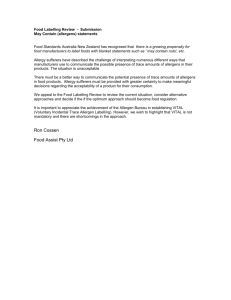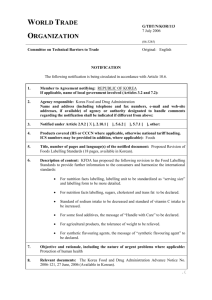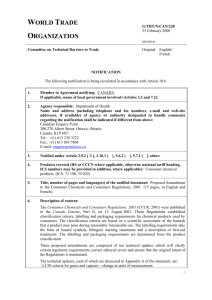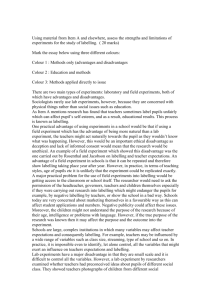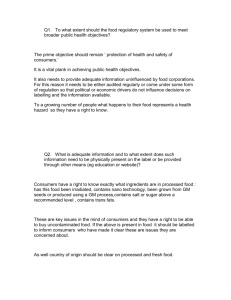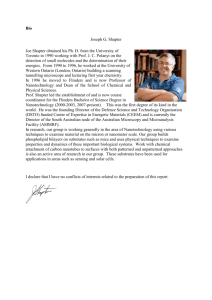carbon labelling framework for construction materials
advertisement
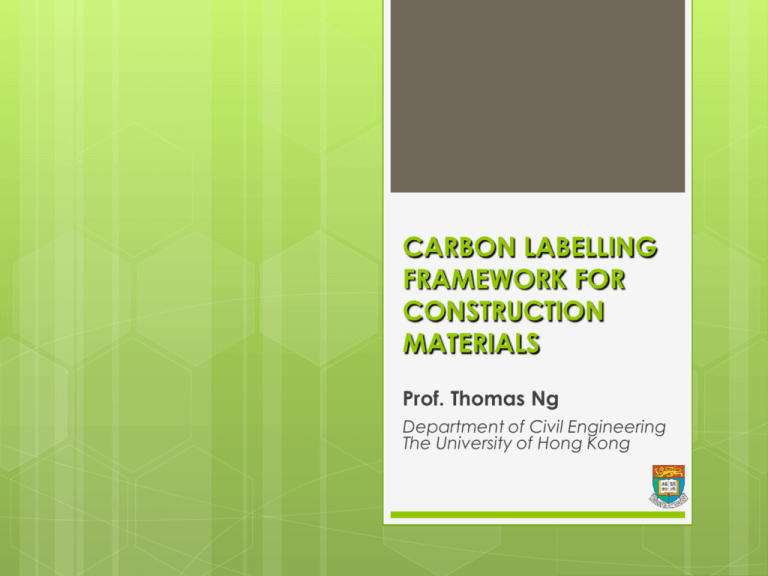
CARBON LABELLING FRAMEWORK FOR CONSTRUCTION MATERIALS Prof. Thomas Ng Department of Civil Engineering The University of Hong Kong Carbon Labelling Framework For Construction Materials Contents I. Why We Need a Carbon Label for Construction Materials? II. The Carbon Labelling Framework Assessment Framework Initial Benchmarks CO2e III. Building a Low Carbon Future 2 CARBON LABELLING FRAMEWORK FOR CONSTRUCTION MATERIALS I. Why We Need a Carbon Label for Construction Materials? CARBON LABELLING H O N G K O N G “Warming of the climate system is unequivocal” “The increase in global average temperatures since the mid-20th century is very likely due to the observed increase in anthropogenic greenhouse gas concentrations” Climate Change 2007, the Fourth Assessment Report, United Nations Intergovernmental Panel on Climate Change 4 Hong Kong’s Carbon Footprint: 1962-2007 Source: WWF-Hong Kong (2011), Hong Kong Ecological Footprint Report 2010, Paths to Sustainable Future, Hong Kong 5 Carbon Labelling Framework For Construction Materials Why We Need a Carbon Label for Construction Materials? Manufacturing of construction materials could contribute to 70% of GHG emissions at the construction stage, and 15% of a building’s life time energy consumption No unanimous definition for “low carbon” materials, nor agreed method for evaluating the carbon footprint of construction materials 6 Carbon Labelling Framework For Construction Materials Making Decisions at Early Stages Source: Fieldson et al., 2009 7 Carbon Labelling Framework For Construction Materials Examples of Product Carbon Labels Worldwide UK JAPAN USA FRANCE KOREA N. AMERICA CANADA TAIWAN 8 Carbon Labelling Framework For Construction Materials A Carbon Labelling Scheme is critical and effective in reducing the carbon footprint of construction projects in Hong Kong C A R B O N LABELLING H Cement Rebar Structural Steel O N G K Aluminium O N G Glass Ceramic Tiles 9 Carbon Labelling Framework For Construction Materials Development Process Review Existing Carbon Labelling Schemes • Relevant standards/ frameworks • Benchmarking mechanism • Carbon inventory • Implementation Strategies Desktop Study & Data Collection Examine Implications of Carbon Labelling in Construction Develop a Carbon Labelling Scheme for Construction Materials Formulate Strategies and Implementation Plans • Industry perceptions, concerns, obstacles • Characteristics and supply chain of selected materials • Carbon assessment methodology and framework • Benchmarks setting and Benchmarking mechanism • Voluntary / mandatory schemes • Roles of various industry stakeholders Expert Interviews (1st round, N=13) Expert Interviews (2nd round, N=11; 3rd round, N=10), Consultation Forum & Questionnaire Survey 10 CARBON LABELLING FRAMEWORK FOR CONSTRUCTION MATERIALS II. The Carbon Labelling Framework: Assessment Framework Product Categories Normative References Carbon Assessment Principles and Requirements Demonstration: Cement Product Categories Carbon Labelling Framework For Construction Materials Material Central Product Classification (CPC) Product Category under the Labelling Scheme Cement Class 3744 All cement products using in construction including Portland cement, Portland-composite cement, Blast furnace cement; Pozzolanic cement; and composite cement 1 tonne Rebar & Structural Steel Division 41 Four major types of steel products used in construction : 1.Steel sections 2.Steel plates 3.Steel pipes 4.Reinforcement bars 1 tonne Aluminium Division 41 All aluminium products used in construction including powders and flakes; bars, rods and profiles; wire; plates, sheets and strip of a thickness exceeding 0.2mm; foil, of a thickness not exceeding 0.2mm; tubes, pipes and tube or pipe fittings 1 tonne Glass Class 3711 1. Glass for internal use (float glass; tinted glass; wired 1 tonne Ceramic Tiles Group 373 (based on ICE in UK and relevant standards if appropriate) glass; heat-strengthened/ toughened glass; laminated glass) 2. Glass for external use (float glass; surface-coated glass - lowE glass, reflective glass; insulated glass unit) All ceramic tiles for both internal and external use Functional Unit 1 m2 1 tonne 12 Carbon Labelling Framework For Construction Materials Normative References PAS 2050:2011, Specification for the Assessment of Life Cycle Greenhouse Gas Emissions of Goods and Services, British Standard Institute (BSI), UK BS EN ISO 14025:2010, Environmental Labels and Declarations – Type III Environmental Declarations – Principles and Procedures BS EN ISO 14044:2006, Environmental Management – Life Cycle Assessment – Requirements and Guidelines IPCC: 2006, Guidelines for National Greenhouse Gas Inventories, National Greenhouse Gas Inventories Programme, IPCC 13 Carbon Labelling Framework For Construction Materials Principles of Carbon Assessment Accuracy Transparency Consistency Product Carbon Footprint Assessment Relevance Completeness Source: ISO 14064-1:2006 14 Carbon Labelling Framework For Construction Materials Requirements of Carbon Assessment - Scope Cover six types of GHGs, namely CO2, methane (CH4), nitrous oxide (N2O), hydrofluorocarbons (HFCs), perfluorocarbons (PFCs) and sulphur hexafluoride (SF6) which impact directly on global warming Measure by mass and then be converted into CO2e emissions using the latest IPCC 100-year global warming potential (GWP) coefficients 15 Carbon Labelling Framework For Construction Materials Requirements of Carbon Assessment - Scope (cont.) Assesses GHG emissions from “cradle to site”, including raw materials extraction, manufacturing, and transporting the product to HK (except for external glass, the carbon saving is assessed during the usage phase) “cradle to site” 16 Carbon Labelling Framework For Construction Materials Requirements of Carbon Assessment - Scope (cont.) The following sources of emissions contributed to >1% of the product’s anticipated life cycle GHG emissions should be included energy use combustion processes chemical reactions loss to atmosphere of refrigerants and other fugitive GHGs process operations service provision and delivery land use and land use change waste management 17 Carbon Labelling Framework For Construction Materials Requirements of Carbon Assessment - Footprint Assessment Process Source: PAS 2050:2011 18 Carbon Labelling Framework For Construction Materials System Boundary for Estimating Carbon Footprint of Cement Products Upstream Processes • • • • Extraction and production of raw materials Transportation of raw material to the plant Recycling process of recycled materials used in a product Energy used in raw material production Core Processes • • • • Production of raw mix Burning of clinker Grinding of cement Storage of cement for dispatch Downstream Process • Transportation from manufacturing to the border of HK 19 Carbon Labelling Framework For Construction Materials Process Map of Cement Products 20 Carbon Labelling Framework For Construction Materials Carbon Assessment Tool of Cement Products 21 CARBON LABELLING FRAMEWORK FOR CONSTRUCTION MATERIALS II. The Carbon Labelling Framework: Initial Benchmarks Benchmarking Mechanisms Adopted in Worldwide Ecolabelling Schemes Review of Carbon Inventories Initial Benchmarks The Carbon Label Design Carbon Labelling Framework For Construction Materials Benchmarking Mechanisms Adopted in Worldwide Eco-labelling Schemes Award labels Regime Award to products that produce less GHGs than a predetermined emission level Examples Energy Star (US) Green Label Scheme (HK) European EcoLabel (EU) Scoring / percentage labels Award to products that reduce GHGs emission to a certain percentage compared to conventional production Carbon Trust (UK) Thailand Greenhouse Gas Management Organisation labels Tiered rating / grading labels Products are labelled in different grades / tiers according to their performance among suppliers Voluntary Energy Efficiency Labelling Scheme (HK) Product Certification (Singapore) China Energy Label Local industry practitioners consulted generally preferred the multiple benchmarking mechanism so as to motivate material suppliers channelling continuous effort in reducing carbon footprint 23 Carbon Labelling Framework For Construction Materials Benchmarking Mechanisms Adopted in Worldwide Eco-labelling Schemes (cont.) Benchmarking intervals usually range between10-15% (for labelling schemes with five grades); with the benchmarking interval being narrower for the higher grades (~10%) than that for the lower grade (~15-20%) To promote industry participation, many labelling schemes do not impose a minimum requirement for the lowest grade The reference value for benchmarking is commonly set by taking the average performance of a specific product category 24 Carbon Labelling Framework For Construction Materials Review of Carbon Inventories As a local carbon inventory is unavailable, the benchmarks of specific product category were initially set by referring to three prominent overseas inventories: i. Ecoinvent in Switzerland ii. US Life Cycle Inventory (LCI) iii. Inventory of Carbon and Energy (ICE) in UK The emission data in these inventories are considered rigorous and reliable for formulating the initial benchmarks of the carbon labelling scheme 25 Carbon Labelling Framework For Construction Materials Review of Carbon Inventories (cont.) Country of Origin Materials Included Data source Cement Rebar & Structural Steel Aluminium Glass Ceramic Tiles ICE US LCI Ecoinvent United Kingdom United States Switzerland 35 construction material groups; over 200 materials Over 180 materials 125 building materials; over 4000 processes Local Providers (e.g. US Literature (journal Environmental articles, LCA, books, Protection Agency, conference papers, etc. Portland Cement Association, etc.) No. Records Literature and Local Providers 94 5 159 N.A. 111 N.A. 3 75 2 limited 1 26 Carbon Labelling Framework For Construction Materials Initial Benchmarks where: •Eda refers to the average carbon emission value obtained from overseas databases: Ecoinvent, ICE & US life cycle inventory (US LCI) •Em refers to the submitted carbon emission value The intervals are subject to review based on local data The benchmarks should be replaced by local data and adjusted on a regular basis in the long run 27 Carbon Labelling Framework For Construction Materials Initial Benchmarks of Cement Products where: •Em refers to the submitted carbon emission value 28 Carbon Labelling Framework For Construction Materials The Carbon Label Design Details of the product including name of product, size / weight, assessment boundary, etc. Carbon footprint of the product in CO2e over different key life cycle stages Awarded grade of the product based on the pre-determined benchmarks Detail information of the label including the assessment method and the authorising organisation 29 Carbon Labelling Framework For Construction Materials Significance of the Carbon Labelling Scheme CARBON LABELLING H O N G K O N G Robust and standardised frameworks for assessing and reporting the carbon footprint of the six selected construction materials Assist clients, design team members and contractors to select low carbon materials Generate market force to promote a low carbon manufacturing and production process Regular review of benchmarks shall encourage manufacturers for continuous improvement 30 CARBON LABELLING FRAMEWORK FOR CONSTRUCTION MATERIALS III. Building a Low Carbon Future Implementing the Labelling Scheme Challenges Ahead Recommendations Carbon Labelling Framework For Construction Materials Implementing the Labelling Scheme - Lessons Learnt from Overseas Experiences Implemented on a voluntary basis, a series of education and publicity campaigns would help enhance the awareness of industry practitioners on the importance of assessing carbon footprint (experience from US and Japan) Provision of incentives is a critical success factor for any green initiatives especially during the early stage of implementation (experience from UK) Government being one of the major clients in construction shall play a leading role in driving the carbon labelling (experience from US and Japan) While carbon labelling is a novel concept, it would be more practical and feasible to implement the labelling scheme in a progressive manner (experience from Japan) 32 Implementing the Labelling Scheme Carbon Labelling Framework For Construction Materials Carbon Labelling Framework For Construction Materials Challenges of Implementing the Carbon Labelling Scheme Challenges Remedies Upstream data (e.g. emissions of raw material extraction) Use the most reliable set of secondary data Credibility of data submitted by material suppliers A rigorous certification process Overseas data are used in setting initial benchmarks in some product categories Collect emission data to develop local database Full promotion of the initial Limited application of carbon implementation of the carbon label labelling scheme 34 Carbon Labelling Framework For Construction Materials Building a Low Carbon Future The Carbon Labelling Scheme: Establishing a local carbon inventory and thereby the localised benchmarks Extending the scope Exploring various incentives Export to overseas markets Recycle / reuse of the end-of-life materials Use local / regional manufactured materials Construction material / waste reduction (e.g. modular design; prefabrication; BIM) Green procurement (e.g. incorporating project carbon footprint into bid evaluation; pay for the environment) Carbon tax / trading 35 Thank you CO2e CARBON LABELLING FRAMEWORK FOR CONSTRUCTION MATERIALS Prof. Thomas Ng Department of Civil Engineering The University of Hong Kong tstng@hku.hk

